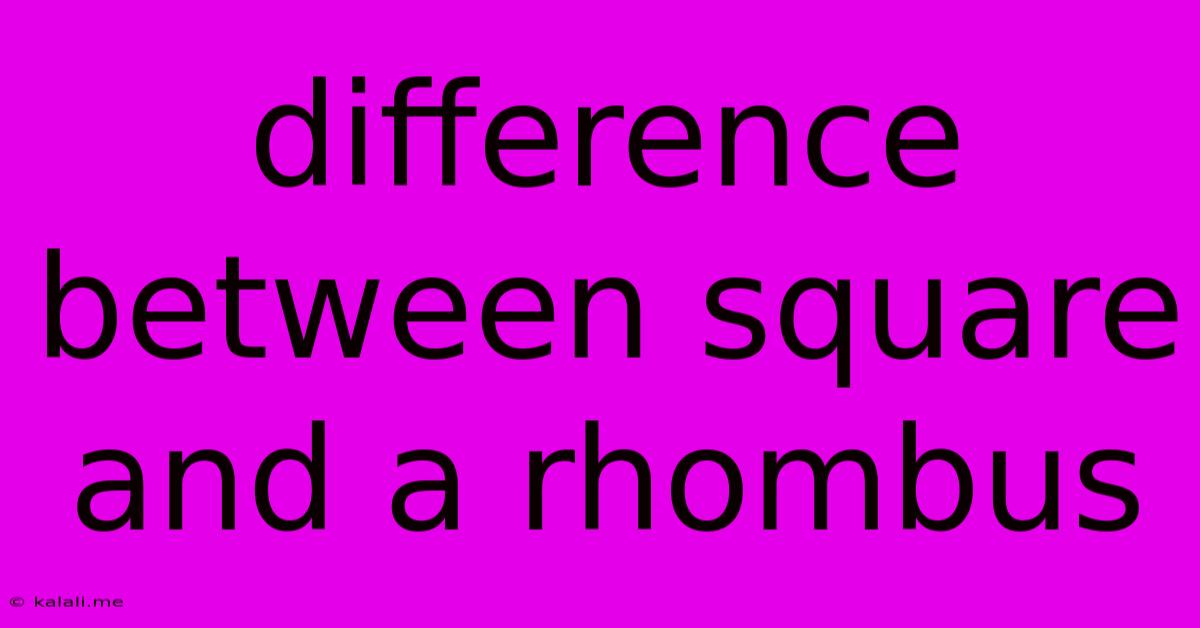Difference Between Square And A Rhombus
Kalali
Jun 13, 2025 · 2 min read

Table of Contents
Square vs. Rhombus: Unveiling the Key Differences
Understanding the distinctions between squares and rhombuses can be tricky, as they share some key characteristics. Both are quadrilaterals – four-sided polygons – but their defining features set them apart. This article will delve into the crucial differences, ensuring you can confidently identify each shape. We'll explore their angles, sides, and diagonals to illuminate their unique geometric properties.
Shared Characteristics: What Makes Them Similar?
Before diving into their differences, let's acknowledge their similarities. Both squares and rhombuses possess these traits:
- Four Sides: Both shapes have four sides.
- Equal Adjacent Sides: All sides are equal in length for both shapes.
Key Differences: Where They Diverge
While sharing a few characteristics, squares and rhombuses diverge significantly in their angles and, consequently, their overall shape.
-
Angles: This is the most significant difference. A square has four 90-degree angles (right angles). A rhombus, on the other hand, has only opposite angles that are equal. These angles do not necessarily have to be 90 degrees; they can be any angle as long as opposite angles are equal. This means a rhombus can be slanted or "tilted."
-
Diagonals: The diagonals of a square are equal in length and bisect each other at right angles. In a rhombus, the diagonals also bisect each other, but they are not necessarily equal in length. They bisect each other at right angles only if the rhombus is also a square.
-
Symmetry: A square has four lines of symmetry (two diagonal and two vertical/horizontal). A rhombus possesses two lines of symmetry (only along its diagonals).
Visualizing the Difference
Imagine a square. Now, gently push one of its corners. You’ve transformed the square into a rhombus! The sides remain equal, but the angles are no longer all 90 degrees. This simple visualization clearly demonstrates the fundamental distinction.
Summary Table: Square vs. Rhombus
For a quick overview, consider this summary table:
| Feature | Square | Rhombus |
|---|---|---|
| Number of Sides | 4 | 4 |
| Side Lengths | All sides are equal | All sides are equal |
| Angles | Four 90-degree angles | Opposite angles are equal |
| Diagonals | Equal in length, bisect at 90 degrees | Bisect each other, not necessarily equal in length |
| Symmetry | Four lines of symmetry | Two lines of symmetry |
Conclusion: Understanding the Nuances
While both squares and rhombuses share the fundamental characteristic of having four equal sides, their angular properties define their distinct identities. Understanding these differences is crucial for anyone working with geometry, from students tackling math problems to professionals in design or engineering. By grasping the key distinctions between a square and a rhombus, you’ll enhance your geometric knowledge and problem-solving skills.
Latest Posts
Latest Posts
-
Able To Be Drawn Into Wire
Jun 14, 2025
-
Which Of The Following Statements Is True Regarding
Jun 14, 2025
-
What Is The Least Common Multiple Of 20 And 40
Jun 14, 2025
-
Temple University Japan Campus Acceptance Rate
Jun 14, 2025
-
Which Of The Following Is Not An Aspect Of Globalization
Jun 14, 2025
Related Post
Thank you for visiting our website which covers about Difference Between Square And A Rhombus . We hope the information provided has been useful to you. Feel free to contact us if you have any questions or need further assistance. See you next time and don't miss to bookmark.